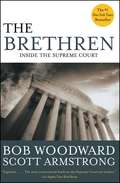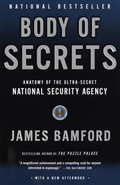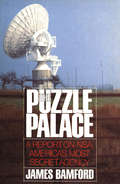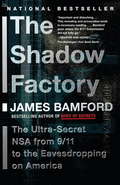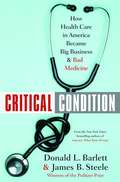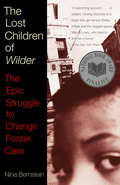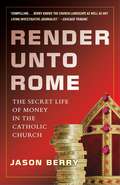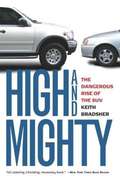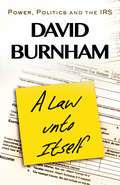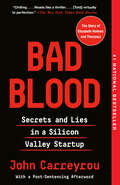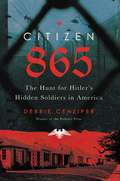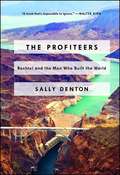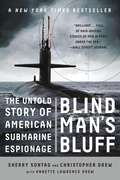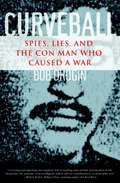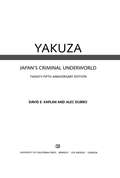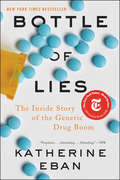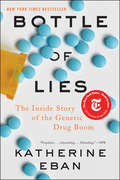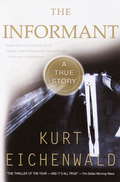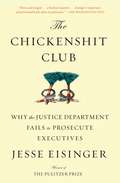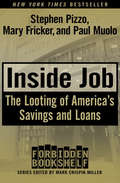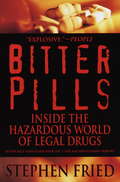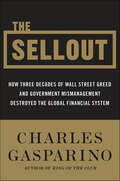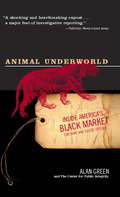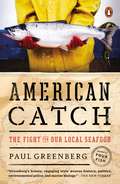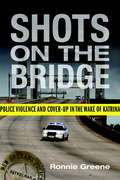Special Collections
Investigative Reporters and Editors Award
Description: The annual IRE Awards recognize outstanding investigative work and help identify the techniques and resources used to complete each story. This collection includes award winners and finalists. #award
- Table View
- List View
The Brethren
by Bob Woodward and Scott ArmstrongThe Brethren is the first detailed behind-the-scenes account of the Supreme Court in action.Bob Woodward and Scott Armstrong have pierced its secrecy to give us an unprecedented view of the Chief and Associate Justices--maneuvering, arguing, politicking, compromising and making decisions that affect every major area of American life.
Body of Secrets
by James BamfordThe NSA is the largest, most secretive and most powerfull intelligence agency in the world. With a staff of 38,000 people, it dwarfs the CIA in budget, manpower and influence. Recent headlines have linked it to economic espionage throughout Europe and to the ongoing hunt for the terrorist leader Osama bin Laden. James Bamford first penetrated the wall of silence surrounding the NSA in 1982, with the much-talked-about US bestseller THE PUZZLE PALACE. In BODY OF SECRETS he offers shocking new details about the inner workings of the agency, gathered through unique access to thousands of internal documents and interviews with current and former officials. Unveiling extremely sensitive information for the first time, Bamford exposes the role the NSA played in numerous Soviet bloc Cold War conflicts and discusses its undercover involvement in the Vietnam War. His investigation into the NSA's technological advances during the last 15 years brings to light a network of global surveillance ranging from on-line listening posts to sophisticated intelligence-gathering satellites. In a hard-hitting conclusion, he warns the NSA is a double-edged sword: while its worldwide eavesdropping activities offer the potential for tracking down terrorists and uncovering nuclear weapons deals, it also has the capacity to listen in on global personal communications.
The Puzzle Palace
by James BamfordThe first book ever written on the National Security Agency from the New York Times bestselling author of Body of Secrets and The Shadow Factory. In this groundbreaking, award-winning book, James Bamford traces the NSA&’s origins, details its inner workings, and explores its far-flung operations. He describes the city of fifty thousand people and nearly twenty buildings that is the Fort Meade headquarters of the NSA—where there are close to a dozen underground acres of computers, where a significant part of the world&’s communications are monitored, and where reports from a number of super-sophisticated satellite eavesdropping systems are analyzed. He also gives a detailed account of NSA&’s complex network of listening posts—both in the United States and throughout much of the rest of the world. When a Soviet general picks up his car telephone to call headquarters, when a New York businessman wires his branch in London, when a Chinese trade official makes an overseas call, when the British Admiralty urgently wants to know the plans and movements of Argentina&’s fleet in the South Atlantic—all of these messages become NSA targets. James Bamford&’s illuminating book reveals how NSA&’s mission of Signals Intelligence (SIGINT) has made the human espionage agent almost a romantic figure of the past. Winner Best Investigative Book of the Year Award from Investigative Reporters & Editors &“The Puzzle Palace has the feel of an artifact, the darkly revealing kind. Though published during the Reagan years, the book is coolly subversive and powerfully prescient.&”—The New Yorker &“Mr. Bamford has emerged with everything except the combination to the director&’s safe.&”—The New York Times Book Review
The Shadow Factory
by James BamfordJames Bamford has been the preeminent expert on the National Security Agency since his reporting revealed the agency’s existence in the 1980s. Now Bamford describes the transformation of the NSA since 9/11, as the agency increasingly turns its high-tech ears on the American public. The Shadow Factoryreconstructs how the NSA missed a chance to thwart the 9/11 hijackers and details how this mistake has led to a heightening of domestic surveillance. In disturbing detail, Bamford describes exactly how every American’s data is being mined and what is being done with it. Any reader who thinks America’s liberties are being protected by Congress will be shocked and appalled at what is revealed here.
Critical Condition
by Donald L. Barlett and James B. SteeleExposing the most controversial, little-known practices of America’s most flawed system, Time magazine’s Pulitzer Prize-winning investigative team pulls back the curtain on the health care industry to explain exactly how things grew so out of control. Dirty examination and operating rooms in doctor’s offices and hospitals . . . Health care executives pulling in millions in bonuses for denying treatment to the sick . . . More than 100 million people with inadequate or no medical coverage . . . This may sound like the predicament of a third-world nation, but this is America’s health care reality today. The U. S. spends more on health care than any other nation, yet our benefits are shrinking and life expectancy is shorter here than in countries that spend significantly less per capita. Meanwhile, HMOs, pharmaceutical companies, and hospital chains reap tremendous profits, while politicians—beholden to insurers and drug companies—enact legislation for the benefit of the few rather than the many, while the entire system is on the verge of collapse. In CRITICAL CONDITION, award-winning investigative journalists Donald L. Barlett and James B. Steele expose the horror of what health care in America has become. They profile patients and doctors trapped by the system and offer startling personal stories that illuminate what’s gone wrong. Doctors tell of being second-guessed and undermined by health care insurers; nurses recount chilling tales of hospital meltdowns; patients explain how they’ve been victimized by a system that is meant to care for them. Drug companies profit by selling pills in the same manner that Madison Avenue sells soap, while Wall Street rakes in billions by building up and then tearing down health care businesses. And politicians pass legislation perpetuating the injustices and out-right fraud the system encourages. By analyzing the industry and offering an insightful prescription for getting it back on the right track, CRITICAL CONDITION is an enormously compelling investigative work that addresses the concerns of every American.
The Lost Children of Wilder
by Nina BernsteinIn 1973 Marcia Lowry, a young civil liberties attorney, filed a controversial class-action suit that would come to be known as Wilder, which challenged New York City's operation of its foster-care system. Lowry's contention was that the system failed the children it was meant to help because it placed them according to creed and convenience, not according to need. The plaintiff was thirteen-year-old Shirley Wilder, an abused runaway whose childhood had been shaped by the system's inequities. Within a year Shirley would give birth to a son and relinquish him to the same failing system. Seventeen years later, with Wilder still controversial and still in court, Nina Bernstein tried to find out what had happened to Shirley and her baby. She was told by child-welfare officials that Shirley had disappeared and that her son was one of thousands of anonymous children whose circumstances are concealed by the veil of confidentiality that hides foster care from public scrutiny. But Bernstein persevered. The Lost Children of Wilder gives us, in galvanizing and compulsively readable detail, the full history of a case that reveals the racial, religious, and political fault lines in our child-welfare system, and lays bare the fundamental contradiction at the heart of our well-intended efforts to sever the destiny of needy children from the fate of their parents. Bernstein takes us behind the scenes of far-reaching legal and legislative battles, at the same time as she traces, in heartbreaking counterpoint, the consequences as they are played out in the life of Shirley's son, Lamont. His terrifying journey through the system has produced a man with deep emotional wounds, a stifled yearning for family, and a son growing up in the system's shadow. In recounting the failure of the promise of benevolence, The Lost Children of Wilder makes clear how welfare reform can also damage its intended beneficiaries. A landmark achievement of investigative reporting and a tour de force of social observation, this book will haunt every reader who cares about the needs of children.From the Hardcover edition.
Render Unto Rome
by Jason BerryAN INVESTIGATION OF EPIC FINANCIAL INTRIGUE, RENDER UNTO ROME EXPOSES THE SECRECY AND DECEIT THAT RUN COUNTER TO THE VALUES OF THE CATHOLIC CHURCH.The Sunday collection in every Catholic church throughout the world is as familiar a part of the Mass as the homily and even Communion. There is no doubt that historically the Catholic Church has been one of the great engines of charity in history. But once a dollar is dropped in that basket, where does it go? How are weekly cash contributions that can amount to tens of thousands of dollars accounted for? Where does the money go when a diocese sells a church property for tens of millions of dollars? And what happens when hundreds of millions of dollars are turned over to officials at the highest ranks, no questions asked, for their discretionary use? The Roman Catholic Church is the largest organization in the world. The Vatican has never revealed its net worth, but the value of its works of art, great churches, property in Rome, and stocks held through its bank easily run into the tens of billions. Yet the Holy See as a sovereign state covers a mere 108 acres and has a small annual budget of about $280 million.No major book has examined the church's financial underpinnings and practices with such journalistic force. Today the church bears scrutiny by virtue of the vast amounts of money (nearly $2 billion in the United States alone) paid out to victims of clergy abuse. Amid mounting diocesan bankruptcies, bishops have been selling off whole pieces of the infrastructure--churches, schools, commercial properties--while the nephew of one of the Vatican's most powerful cardinals engaged in a lucrative scheme to profiteer off the enormous downsizing of American church wealth.From the Hardcover edition.
High and Mighty
by Keith BradsherFrom the book: Sport utility vehicles have taken over America's roads - pushing fuel consumption up and traffic safety down. Keith Bradsher has long been at the forefront of critical SUV coverage and in HIGH AND MIGHTY he delivers a thorough, undeniable indictment of these vehicles as much worse than cars for their occupants, for other motorists, for pedestrians, and for the planet itself. This masterpiece of investigative j'ournalism shows how a flawed regulatory system, a desperate Detroit, and our national love for "bigger and better" have combined to create a highway arms race that puts us all at risk.
A Law Unto Itself
by David BurnhamThis is a fully documented inside examination of the Internal Revenue Service, in many ways the largest and most powerful of all federal agencies, and also the agency whose competent function is most essential to our democracy. The book's appearance in 1989 sparked a public furor and major legislation attempting to redress the IRS' many abuses of power, both political and bureaucratic. The book will be a relevant handbook as long as the agency remains a towering presence in American life.
Bad Blood
by John CarreyrouThe full inside story of the breathtaking rise and shocking collapse of Theranos, the multibillion-dollar biotech startup, by the prize-winning journalist who first broke the story and pursued it to the end, despite pressure from its charismatic CEO and threats by her lawyers.
In 2014, Theranos founder and CEO Elizabeth Holmes was widely seen as the female Steve Jobs: a brilliant Stanford dropout whose startup "unicorn" promised to revolutionize the medical industry with a machine that would make blood testing significantly faster and easier.
Backed by investors such as Larry Ellison and Tim Draper, Theranos sold shares in a fundraising round that valued the company at more than $9 billion, putting Holmes's worth at an estimated $4.7 billion.
There was just one problem: The technology didn't work.
A riveting story of the biggest corporate fraud since Enron, a tale of ambition and hubris set amid the bold promises of Silicon Valley.
A New York Times Bestseller
Citizen 865
by Debbie CenziperThe gripping story of a team of Nazi hunters at the U.S. Department of Justice as they raced against time to expose members of a brutal SS killing force who disappeared in America after World War Two.In 1990, in a drafty basement archive in Prague, two American historians made a startling discovery: a Nazi roster from 1945 that no Western investigator had ever seen. The long-forgotten document, containing more than 700 names, helped unravel the details behind the most lethal killing operation in World War Two. In the tiny Polish village of Trawniki, the SS set up a school for mass murder and then recruited a roving army of foot soldiers, 5,000 men strong, to help annihilate the Jewish population of occupied Poland. After the war, some of these men vanished, making their way to the U.S. and blending into communities across America. Though they participated in some of the most unspeakable crimes of the Holocaust, "Trawniki Men" spent years hiding in plain sight, their terrible secrets intact.In a story spanning seven decades, Citizen 865 chronicles the harrowing wartime journeys of two Jewish orphans from occupied Poland who outran the men of Trawniki and settled in the United States, only to learn that some of their one-time captors had followed. A tenacious team of prosecutors and historians pursued these men and, up against the forces of time and political opposition, battled to the present day to remove them from U.S. soil. Through insider accounts and research in four countries, this urgent and powerful narrative provides a front row seat to the dramatic turn of events that allowed a small group of American Nazi hunters to hold murderous men accountable for their crimes decades after the war's end.
The Profiteers
by Sally DentonFrom the bestselling coauthor of The Money and the Power (which the Los Angeles Times called "one of the most important nonfiction books published in a half century")--the inside story of the Bechtel family and the empire they've controlled since the construction of the Hoover Dam.The tale of the Bechtel family dynasty is a classic American business story. It begins with Warren A. "Dad" Bechtel, who led a consortium that constructed the Hoover Dam. From that auspicious start, the family and its eponymous company would go on to "build the world," from the construction of airports in Hong Kong and Doha, to pipelines and tunnels in Alaska and Europe, to mining and energy operations around the globe. Today Bechtel is one of the largest privately held corporations in the world, enriched and empowered by a long history of government contracts and the privatization of public works, made possible by an unprecedented revolving door between its San Francisco headquarters and Washington. Bechtel executives John McCone, Caspar Weinberger, and George P. Shultz segued from leadership at the company to positions as Director of the CIA, Secretary of Defense, and Secretary of State, respectively. Like all stories of empire building, the rise of Bechtel presents a complex and riveting narrative. In The Profiteers, Sally Denton, whom The New York Times called "a wonderful writer," exposes Bechtel's secret world and one of the biggest business and political stories of our time.
Blind Man's Bluff
by Sherry Sontag and Christopher Drew and Annette Lawrence DrewOver the course of five years, investigative reporters Sherry Sontag and Chris Drew interviewed hundreds of men who had never spoken about their underwater lives-not even to their wives and children. They uncovered a wealth of classified information: the tapping of undersea Soviet telephone cables, the stealing of Soviet weapons, the tragic collisions of enemy submarines. They tell of medals awarded in secret and deaths disguised with disinformation. Blind Man's Bluff is a critical work of history that reads with all the excitement of a Tom Clancy novel and all the tragedy of Das Boot.
Curveball
by Bob DroginCurveball answers the crucial question of the Iraq war: How and why was America's intelligence so catastrophically wrong? In this dramatic and explosive book, award-winning Los Angeles Times reporter Bob Drogin delivers a narrative that takes us to Europe, the Middle East, and deep inside the CIA to find the truth about the lies and self-deception that led us into a military and political nightmare.
Yakuza
by Alec Dubro and David E. KaplanKnown for their striking full-body tattoos and severed fingertips, Japan's gangsters comprise a criminal class eighty thousand strong--more than four times the size of the American mafia. Despite their criminal nature, the yakuza are accepted by fellow Japanese to a degree guaranteed to shock most Westerners. Yakuza is the first book to reveal the extraordinary reach of Japan's Mafia. Originally published in 1986, it was so controversial in Japan that it could not be published there for five years. But in the west it has long served as the standard reference on Japanese organized crime and has inspired novels, screenplays, and criminal investigations. This twenty-fifth anniversary edition tells the full story or Japan's remarkable crime syndicates, from their feudal start as bands of medieval outlaws to their emergence as billion-dollar investors in real estate, big business, art, and more.
Bottle of Lies
by Katherine EbanFrom an award-winning journalist, an explosive narrative investigation of the generic drug boom that reveals fraud and life-threatening dangers on a global scale—The Jungle for pharmaceuticalsMany have hailed the widespread use of generic drugs as one of the most important public-health developments of the twenty-first century. Today, almost 90 percent of our pharmaceutical market is comprised of generics, the majority of which are manufactured overseas. We have been reassured by our doctors, our pharmacists and our regulators that generic drugs are identical to their brand-name counterparts, just less expensive. But is this really true?Katherine Eban’s Bottle of Lies exposes the deceit behind generic-drug manufacturing—and the attendant risks for global health. Drawing on exclusive accounts from whistleblowers and regulators, as well as thousands of pages of confidential FDA documents, Eban reveals an industry where fraud is rampant, companies routinely falsify data, and executives circumvent almost every principle of safe manufacturing to minimize cost and maximize profit, confident in their ability to fool inspectors. Meanwhile, patients unwittingly consume medicine with unpredictable and dangerous effects.The story of generic drugs is truly global. It connects middle America to China, India, sub-Saharan Africa and Brazil, and represents the ultimate litmus test of globalization: what are the risks of moving drug manufacturing offshore, and are they worth the savings? A decade-long investigation with international sweep, high-stakes brinkmanship and big money at its core, Bottle of Lies reveals how the world’s greatest public-health innovation has become one of its most astonishing swindles.
Bottle of Lies
by Katherine EbanA NEW YORK TIMES BESTSELLER New York Times 100 Notable Books of 2019New York Public Library Best Books of 2019 Kirkus Reviews Best Health and Science Books of 2019Science Friday Best Books of 2019 New postscript by the authorFrom an award-winning journalist, an explosive narrative investigation of the generic drug boom that reveals fraud and life-threatening dangers on a global scale—The Jungle for pharmaceuticalsMany have hailed the widespread use of generic drugs as one of the most important public-health developments of the twenty-first century. Today, almost 90 percent of our pharmaceutical market is comprised of generics, the majority of which are manufactured overseas. We have been reassured by our doctors, our pharmacists and our regulators that generic drugs are identical to their brand-name counterparts, just less expensive. But is this really true?Katherine Eban’s Bottle of Lies exposes the deceit behind generic-drug manufacturing—and the attendant risks for global health. Drawing on exclusive accounts from whistleblowers and regulators, as well as thousands of pages of confidential FDA documents, Eban reveals an industry where fraud is rampant, companies routinely falsify data, and executives circumvent almost every principle of safe manufacturing to minimize cost and maximize profit, confident in their ability to fool inspectors. Meanwhile, patients unwittingly consume medicine with unpredictable and dangerous effects.The story of generic drugs is truly global. It connects middle America to China, India, sub-Saharan Africa and Brazil, and represents the ultimate litmus test of globalization: what are the risks of moving drug manufacturing offshore, and are they worth the savings? A decade-long investigation with international sweep, high-stakes brinkmanship and big money at its core, Bottle of Lies reveals how the world’s greatest public-health innovation has become one of its most astonishing swindles.
The Informant
by Kurt EichenwaldFrom an award-winning New York Times investigative reporter comes an outrageous story of greed, corruption, and conspiracy--which left the FBI and Justice Department counting on the cooperation of one man . . .
It was one of the FBI's biggest secrets: a senior executive with America's most politically powerful corporation, Archer Daniels Midland, had become a confidential government witness, secretly recording a vast criminal conspiracy spanning five continents.
Mark Whitacre, the promising golden boy of ADM, had put his career and family at risk to wear a wire and deceive his friends and colleagues. Using Whitacre and a small team of agents to tap into the secrets at ADM, the FBI discovered the company's scheme to steal millions of dollars from its own customers. But as the FBI and federal prosecutors closed in on ADM, using stakeouts, wiretaps, and secret recordings of illegal meetings around the world, they suddenly found that everything was not all that it appeared.
At the same time Whitacre was cooperating with the Feds while playing the role of loyal company man, he had his ownagenda he kept hidden from everyone around him--his wife, his lawyer, even the FBI agents who had come to trust him with the case they had put their careers on the line for. Whitacre became sucked into his own world of James Bond antics, imperiling the criminal case and creating a web of deceit that left the FBI and prosecutors uncertain where the lies stopped and the truth began.
In this gripping account unfolds one of the most captivating and bizarre tales in the history of the FBI and corporate America.
Meticulously researched and richly told by New York Times senior writer Kurt Eichenwald, The Informant re-creates the drama of the story, beginning with the secret recordings, stakeouts, and interviews with suspects and witnesses to the power struggles within ADM and its board--including the high-profile chairman Dwayne Andreas, F. Ross Johnson, and Brian Mulroney--to the big-gun Washington lawyers hired by ADM and on up through the ranks of the Justice Department to FBI Director Louis Freeh and Attorney General Janet Reno.A page-turning real-life thriller that features deadpan FBI agents, crooked executives, idealistic lawyers, and shady witnesses with an addiction to intrigue, The Informant tells an important and compelling story of power and betrayal in America.
A New York Times Bestseller
The Chickenshit Club
by Jesse EisingerFrom Pulitzer Prize–winning journalist Jesse Eisinger, a blistering account of corporate greed and impunity, and the reckless, often anemic response from the Department of Justice.Why were no bankers put in prison after the financial crisis of 2008? Why do CEOs seem to commit wrongdoing with impunity? The problem goes beyond banks deemed “Too Big to Fail” to almost every large corporation in America—to pharmaceutical companies and auto manufacturers and beyond. The Chickenshit Club—an inside reference to prosecutors too scared of failure and too daunted by legal impediments to do their jobs—explains why. A character-driven narrative, the book tells the story from inside the Department of Justice. The complex and richly reported story spans the last decade and a half of prosecutorial fiascos, corporate lobbying, trial losses, and culture shifts that have stripped the government of the will and ability to prosecute top corporate executives. The book begins in the 1970s, when the government pioneered the notion that top corporate executives, not just seedy crooks, could commit heinous crimes and go to prison. The book travels to trading desks on Wall Street, to corporate boardrooms and the offices of prosecutors and F.B.I agents. These revealing looks provide context for the evolution of the Justice Department’s approach to pursuing corporate criminals through the early aughts and into the Justice Department of today. Exposing one of the most important scandals of our time, The Chickenshit Club provides a clear, detailed explanation as to how our Justice Department has come to avoid, bungle, and mismanage the fight to bring these alleged criminals to justice.
Inside Job
by Paul Muolo and Stephen Pizzo and Mary FrickerA fast-paced and gripping account of one of history's most infamous financial disasters For most of the 20th century, savings and loans were an invaluable thread of the American economy. But in the 1970s, Congress passed sweeping financial deregulation at the insistence of industry insiders that allowed these once quaint and useful institutions to spread their taxpayer-insured assets into new and risky investments. The looser regulations and reduced federal oversight also opened the industry to an army of shady characters, white-collar criminals, and organized crime groups. Less than 10 years later, half the nation's savings and loans were insolvent, leaving the American taxpayer on the hook for a large hunk of the nearly half a trillion dollars that had gone missing. The authors of Inside Job saw signs of danger long before the scandal hit nationwide. Decades after the savings and loan collapse, Inside Job remains a thrilling read and a sobering reminder that our financial institutions are more fragile than they appear.
Bitter Pills
by Stephen FriedWe take our medicines on faith. We assume our doctors are well-informed, our drug companies scrupulous, our FDA diligent--and our medications safe. All too often we're wrong. Just how wrong is documented in this critically acclaimed portrait of the international pharmaceutical industry by one of our most highly respected investigative journalists.According to the Journal of the American Medical Association (JAMA), adverse drug reactions are the fourth leading cause of death in America. Reactions to prescription and over-the-counter medications kill far more people annually than all illegal drug use combined.Stephen Fried's wife took a pill for a minor infection--and ended up in the emergency room. Some drug reactions go away in a few hours or days. Diane's did not. This emotionally wrenching experience launched Fried into a five-year examination of the entire pharmaceutical industry, the most profitable legal business in the world. Rigorously documented, Bitter Pills is a full-scale portrait of pill making and pill taking in America today, presented through the powerful human drama of doctors, patients, drug companies, the FDA, and government regulators as they war for control of our medicine cabinets.From the Trade Paperback edition.
The Sellout
by Charles GasparinoIn the spirit of Barbarians at the Gate and Liar’s Poker comes The Sellout, the definitive book on the recent collapse of Wall Street, one of the most dramatic and anxiety-ridden era in national socioeconomic history. In this powerful business narrative, Charles Gasparino, the author of Blood on the Floor and King of the Club, captures how avarice, arrogance, and sheer stupidity eroded Wall Street’s dominance, made many of our country’s most fabled financial institutions vulnerable to significant new foreign control, and profoundly weakened the financial security of millions of poor and middle-class American families.
Animal Underworld
by Alan GreenA vast and previously undisclosed underground economy exists in the United States. The products bought and sold: animals. In Animal Underworld, veteran investigative journalist Alan Green exposes the sleazy, sometimes illegal web of those who trade in rare and exotic creatures. Green and The Center for Public Integrity reveal which American zoos and amusement parks dump their "surplus" animals on the middlemen adept at secretly redirecting them into the private pet trade. We're taken to exotic-animal auctions, where the anonymous high bidders are often notorious dealers, hunting-ranch proprietors, and profit-minded charlatans masquerading as conservationists. We visit some of the nation's most prestigious universities and research laboratories, whose diseased monkeys are "laundered" through this same network of breeders and dealers until they finally reach the homes of unsuspecting pet owners. And we meet the men and women who make their living by skirting through loopholes in the law, or by ignoring the law altogether. For anyone who cares about animals; for pet owners, zoo-goers, wildlife conservationists, and animal welfare advocates, Animal Underworld is gripping, shocking reading.
American Catch
by Paul GreenbergINVESTIGATIVE REPORTERS & EDITORS Book Award, Finalist 2014
In American Catch, award-winning author Paul Greenberg takes the same skills that won him acclaim in Four Fish to uncover the tragic unraveling of the nation's seafood supply--telling the surprising story of why Americans stopped eating from their own waters. In 2005, the United States imported five billion pounds of seafood, nearly double what we imported twenty years earlier. Bizarrely, during that same period, our seafood exports quadrupled.
American Catch examines New York oysters, Gulf shrimp, and Alaskan salmon to reveal how it came to be that 91 percent of the seafood Americans eat is foreign. In the 1920s, the average New Yorker ate six hundred local oysters a year. Today, the only edible oysters lie outside city limits. Following the trail of environmental desecration, Greenberg comes to view the New York City oyster as a reminder of what is lost when local waters are not valued as a food source. Farther south, a different catastrophe threatens another seafood-rich environment.
When Greenberg visits the Gulf of Mexico, he arrives expecting to learn of the Deepwater Horizon oil spill's lingering effects on shrimpers, but instead finds that the more immediate threat to business comes from overseas. Asian-farmed shrimp--cheap, abundant, and a perfect vehicle for the frying and sauces Americans love--have flooded the American market. Finally, Greenberg visits Bristol Bay, Alaska, home to the biggest wild sockeye salmon run left in the world. A pristine, productive fishery, Bristol Bay is now at great risk: The proposed Pebble Mine project could under¬mine the very spawning grounds that make this great run possible. In his search to discover why this precious renewable resource isn't better protected, Green¬berg encounters a shocking truth: the great majority of Alaskan salmon is sent out of the country, much of it to Asia. Sockeye salmon is one of the most nutritionally dense animal proteins on the planet, yet Americans are shipping it abroad.
Despite the challenges, hope abounds. In New York, Greenberg connects an oyster restoration project with a vision for how the bivalves might save the city from rising tides. In the Gulf, shrimpers band together to offer local catch direct to consumers. And in Bristol Bay, fishermen, environmentalists, and local Alaskans gather to roadblock Pebble Mine. With American Catch, Paul Greenberg proposes a way to break the current destructive patterns of consumption and return American catch back to American eaters.
Shots on the Bridge
by Ronnie GreeneA harrowing story of blue on black violence, of black lives that seemingly did not matter.On September 4, 2005, six days after Hurricane Katrina's landfall in New Orleans, two groups of people intersected on the Danziger Bridge, a low-rising expanse over the Industrial Canal. One was the police who had stayed behind as Katrina roared near, desperate to maintain control as their city spun into chaos. The other was the residents forced to stay behind with them during the storm and, on that fateful Sunday, searching for the basics of survival: food, medicine, security. They collided that morning in a frenzy of gunfire.When the shooting stopped, a gentle forty-year-old man with the mind of a child lay slumped on the ground, seven bullet wounds in his back, his white shirt turned red. A seventeen-year-old was riddled with gunfire from his heel to his head. A mother's arm was blown off; her daughter's stomach gouged by a bullet. Her husband's head was pierced by shrapnel. Her nephew was shot in the neck, jaw, stomach, and hand. Like all the other victims, he was black--and unarmed.Before the blood had dried on the pavement, the shooters, each a member of the New Orleans Police Department, and their supervisors hatched a cover-up. They planted a gun, invented witnesses, and charged two of their victims with attempted murder. At the NOPD, they were hailed as heroes. Shots on the Bridge explores one of the most dramatic cases of police violence seen in our country in the last decade--the massacre of innocent people, carried out by members of the NOPD, in the brutal, disorderly days following Hurricane Katrina. It reveals the fear that gripped the police of a city slid into anarchy, the circumstances that drove desperate survivors to the bridge, and the horror that erupted when the police opened fire. It carefully unearths the cover-up that nearly buried the truth. And finally, it traces the legal maze that, a decade later, leaves the victims and their loved ones still searching for justice. This is the story of how the people meant to protect and serve citizens can do violence, hide their tracks, and work the legal system as the nation awaits justice.From the Hardcover edition.
